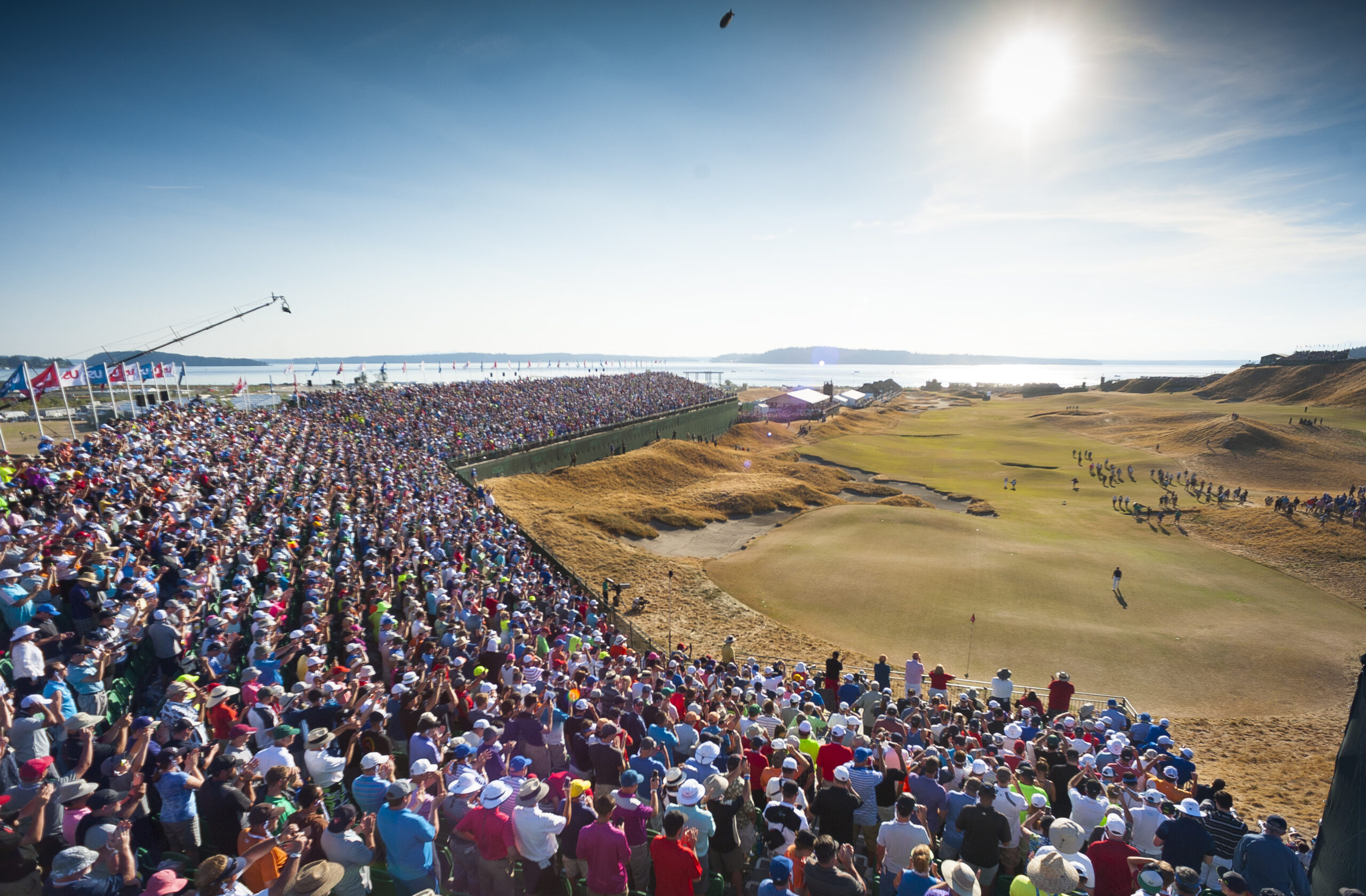
by Paul Ramsdell
Generally, in the midst of most anniversary celebrations, there comes a comment from someone in the crowd about “many more to come.”
For golf fans in the Pacific Northwest, and anyone with a vested interest in Chambers Bay, there’s hope that the 10-year anniversary this summer of the 2015 U.S. Open will spark talk of a return of the world’s best golfers for a second go-round at the layout along the Puget Sound near Tacoma.
If that ever does happen, if the USGA ever decides to bring the U.S. Open back, well, there will be quite a few more anniversaries beforehand.
And, in the meantime, plenty of other USGA championships. The U.S. Junior is coming in 2027, and the U.S. Amateur Four-Ball in 2028; and then the U.S. Amateur in 2033, which will be 23 years after that national championship was first held at Chambers Bay in 2010, when more than 5,000 spectators watched Peter Uihlein grab the match-play title on a warm August afternoon.

“We’re very proud of our relationship with Chambers Bay,” said John Bodenhamer, the chief championships officer for the USGA.
The feeling is reciprocal.
“We have big stuff ahead of us and a really, really positive relationship with the USGA,” said Matt Cohen, the general manager at Chambers Bay, which is owned by Pierce County.
“We’re hopeful that eventually, even if it’s 25 years from now, it will lead to another U.S. Open, whether it’s for the women, senior men or any type.”
In looking back 10 years, while the negatives (namely bumpy greens and crowd-movement issues) at the 2015 U.S. Open grabbed a lot of the attention, there were plenty of positives, especially for Jordan Spieth, who won the title with final-round birdies on Nos. 16 and 18 to survive a double-bogey at No. 17 to finish at 5 under.
“From my standpoint, personally, it was a thrilling U.S. Open,” said Bodenhamer, who grew up in Lakewood not far from where Chambers Bay eventually was built. “I don’t know if we could have had more excitement, a better leaderboard and a greater champion.”

Spieth, of course, avoided a playoff when Dustin Johnson three-putted for par on the 604-yard, par-5 18th. The problems with the greens – fescue, but uneven in spots because of the encroaching Poa annua – were blamed by some for Johnson’s final miscue, but leaving yourself above the hole as Johnson did makes for a challenge on any of the undulating greens at Chambers Bay.
From the players’ standpoint, the greens seemed to be the only issue, even though Chambers Bay was relatively untested as a championship course, having opened just eight years earlier.
“There was nothing negative said about the layout, nothing negative about hole locations, and really, candidly, nothing negative as far as how firm and fast it was,” Bodenhamer said.
What the USGA saw from the Pacific Northwest was jaw-dropping.
“The enthusiasm around the fan base at Chambers Bay coming into it was off the charts,” Bodenhamer said. “We sold out tickets very quickly. Volunteers filled up in a little bit more than 24 hours. We sold more merchandise that week than we had at any other Open previously.”
Cohen, at the time, was watching it all on television, as he was the general manager of a club in Colorado.
“I remember vividly watching during the week,” said Cohen, who took over at Chambers Bay on June 1, 2024. “What really struck me, first of all, was the grandeur of the golf course, the beauty, just the stark kind of setting against Puget Sound, and the uniqueness of the golf course, and how unique it was for the U.S. Open to be conducted on that type of golf course. I thought that was cool.”
But he couldn’t escape the controversy over the greens.
“I remember coming to the defense of the USGA and the golf course with the members of the club I was at the time, and saying, ‘Hey, it’s not supposed to be easy. It is what it is, and they’re doing the best they can, and the players just need to shut up and go out and play. They’re all playing the same track.’”
Cohen doesn’t have to come to the defense of the greens anymore after they were resodded with Poa annua in 2018.
“Since then, the greens are truly as pure a Poa surface as you’ll see anywhere,” Cohen said of the pride and joy of Eric Johnson, the course’s director of agronomy. “Our greens are fantastic now, so that’s in the rearview mirror.”
“In our mind, replacing them with Poa was very positive,” Bodenhamer said. “Primarily because we thought it would be the right thing to do for the long-term benefit of Chambers Bay.”

As far as the other major criticism from 2015 – fan experience walking the golf course – engineers and experts are smart enough, if given a second chance, to figure out ways to correct that problem. Bodenhamer admitted the USGA was too worried about a recurrence of the multiple slips and falls suffered by fans during the 2010 U.S. Amateur.
“If we ever return, we would be less conservative,” he said. “We would let more people in more areas to watch.”
It’s all the negatives from 2015 that didn’t make the headlines that will have a larger bearing on whether a U.S. Open returns to Chambers Bay. In a nutshell, that means money.
“I would say we had a good financial U.S. Open,” Bodenhamer said about 2015. “It was better than average, but not what it could have been.”
Sales of corporate tents didn’t come close to matching the enthusiasm of the individual ticket-buyer.
“We think it was mainly because the Seattle market didn’t really come down to Tacoma,” Bodenhamer said. “That was a bit of a surprise and a disappointment.”
And it’s no secret the state of Washington and its local government entities are mostly funded by sales taxes on goods and services, rather than by any kind of income tax. Putting on a U.S. Open involves a lot of goods and services, and the tax bills can add up quickly.
And when the USGA takes its U.S. Open to some place like Oakmont, as it will this summer, there’s already a majestic clubhouse in place, with a plush locker room and plenty of ornate side rooms to entertain various distinguished guests.
At Chambers Bay, a former gravel pit, building various tents all over the place was expensive, as was taking them down afterward and returning the North Meadow, for example, back to exactly the way it was before the invasion of golf fans.
The bottom line, though, is Chambers Bay still is remarkable for its setting and vistas along Puget Sound. That, combined with the fact it’s a perfect match-play course, makes it a superb location for national championships, as it was for the 2022 U.S. Women’s Amateur and will be for the three upcoming championships when spectators can walk the fairways along with the players.
It’s still nearly every day that someone tells Cohen they traveled a long way to play this golf course.
“We hope that’s still in our future,” he said of a U.S. Open, or a Senior Open or a Women’s Open. “But that being said, it’s one of the things that never goes away. I mean, you’re always a U.S. Open course.”
Paul Ramsdell has been a career-long journalist working at various times with newspapers, magazines and ESPN.com. He currently is the executive director of the Northwest Turfgrass Association, and is past president of Washington Golf.

